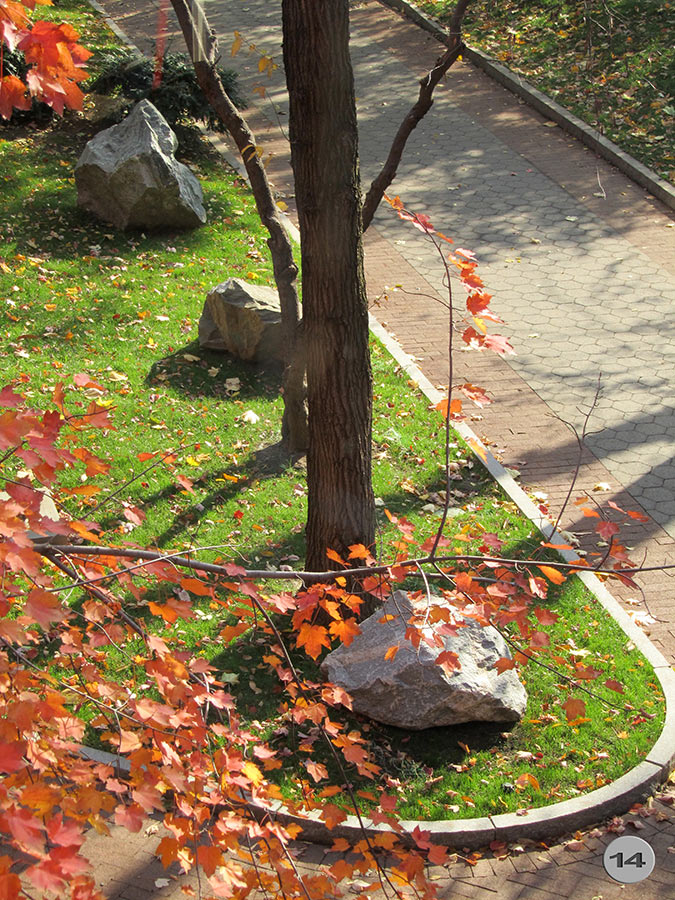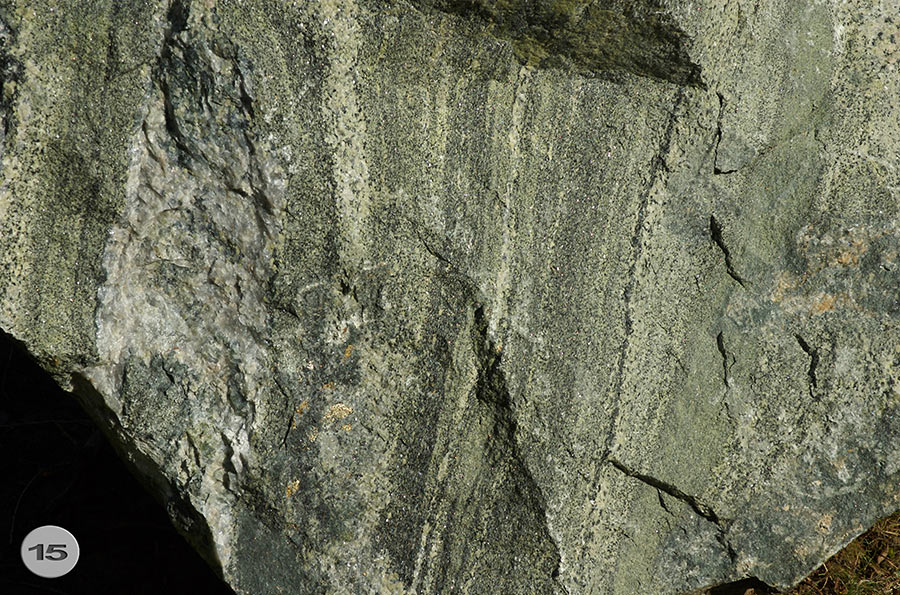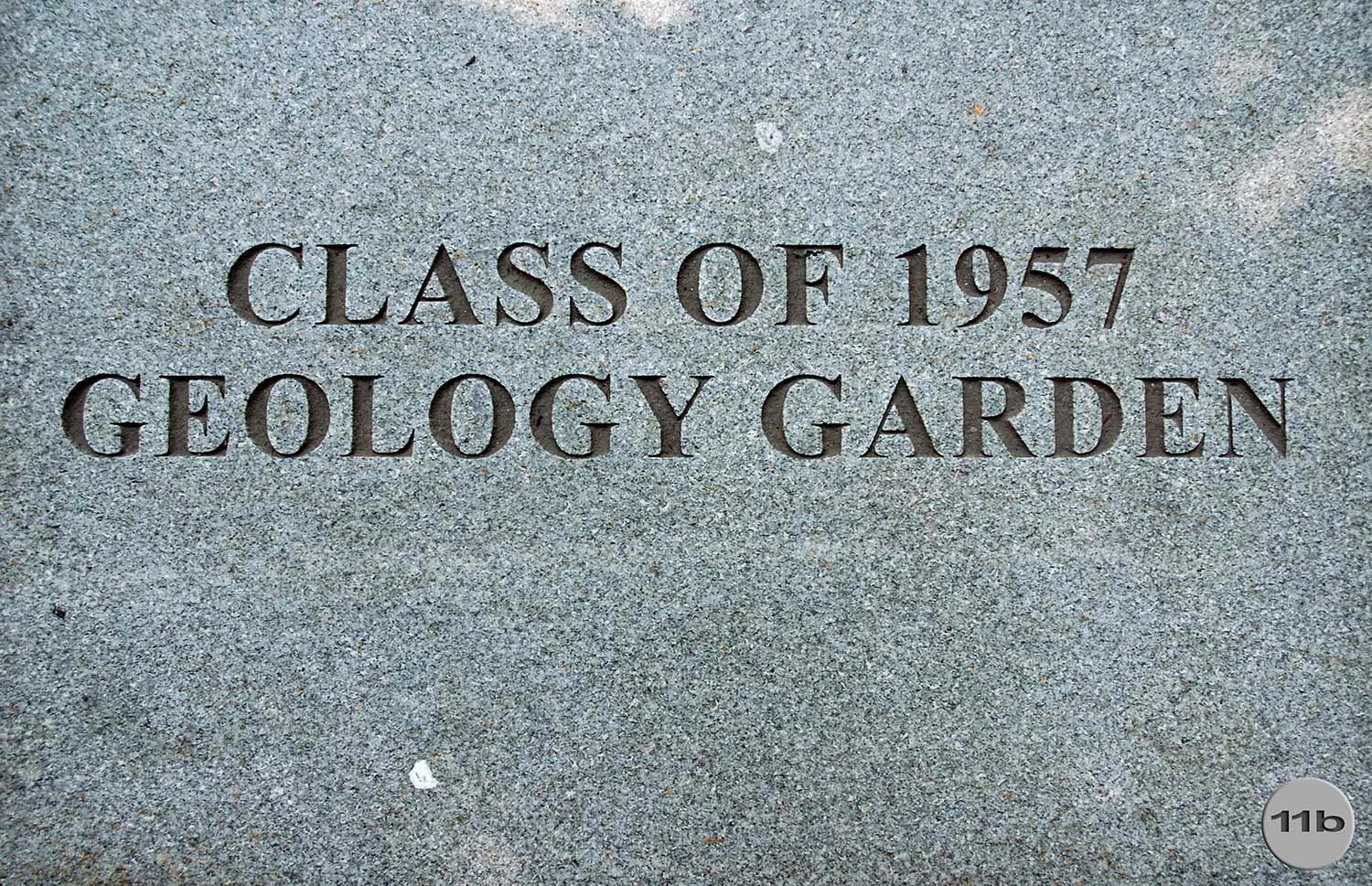University of Pennsylvania
Class of 1957
Geology Garden

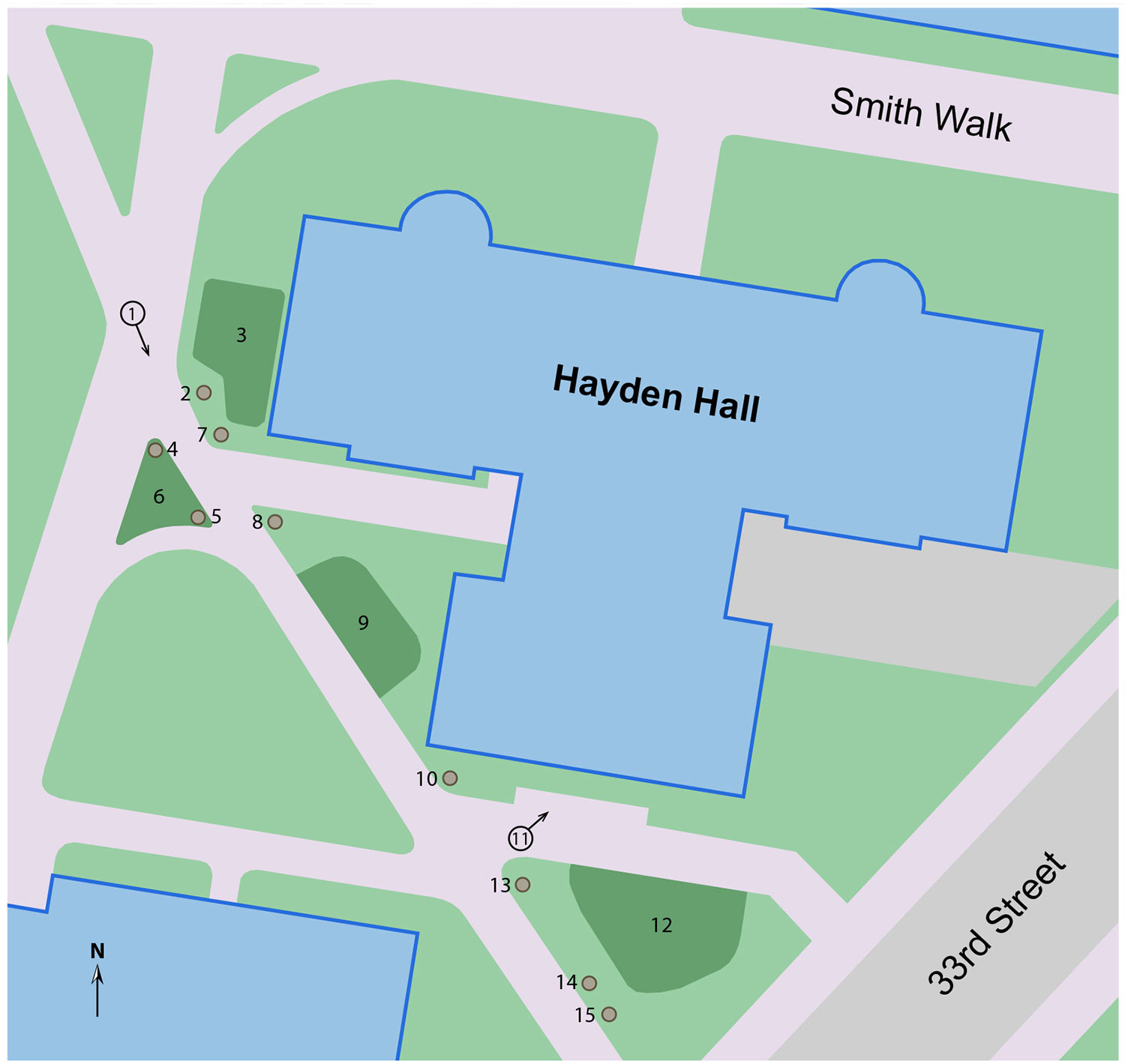
Map of the University of Pennsylvania Geology Garden
Numbers in the map indicate the location of rocks or vegetation mentioned in the text and shown in the photographs.
The Geology Garden at the University of Pennsylvania was created through the generosity of members of the Class of 1957 following a suggestion from Professor Hermann Pfefferkorn. The Garden extends along a diagonal walkway from Smith Walk to 33rd Street, just outside Hayden Hall and the Department of Earth and Environmental Science. Ten boulders represent the geology around Philadelphia from 1 Billion to 25,000 years ago. The younger boulders are near Smith Walk and they become successively older towards 33rd Street. In addition, four plant communities have been planted that existed in North America (7, 25, 45) and about 200 million years ago. When visiting the garden one can dial a telephone number and listen to a lecture by Professor Pfefferkorn. The content of that lecture is presented here in connection with photographs of the garden. Just click on the small images to see a larger version.
This virtual tour begins near Smith Walk. The gray, erratic boulder (2) lying on the east side of the Walk shows glacial striations that were created about 25,000 years ago when a continental ice sheet covered large parts of North America including northern Pennsylvania and all of New York State during the last glacial stage before the current interglacial.
In the same area grow young dawn redwoods (3) with the Latin name Metasequoia. This is a species that was first discovered as a fossil and later as a living tree in China. Forty-five million years ago during the Eocene Epoch of the Early Tertiary (Paleogene) Period this tree was a dominant species in North America when very warm climate allowed plants like these to grow even north of the Arctic Circle and form peat deposits in that area.
On the west side, on a triangular area one can observe a block of dark diabase (4). This is an igneous rock that was produced by volcanic eruptions about two hundred million years ago during the latest part of the Triassic and earliest parts of the Jurassic Periods north and west of Philadelphia. That was the last time volcanism occurred in the Philadelphia area. This particular rock did not form at the surface, but the magma got stuck in other rocks at some depth and cooled slowly.
The red rock that we see in the other corner of the triangular area consists of sandstone and conglomerate (5). The original sand and gravel that later formed this rock was deposited by a river in a rift valley which formed within the supercontinent Pangaea also about 200 million years ago. There were several parallel valleys and one opened up to form the Atlantic. If the valley northwest of Philadelphia had opened instead of another more eastern one the real estate now occupied by the University of Pennsylvania would now be part of Morocco in North Africa.
These two rocks lie in the triangular area that has trees, but is also a grassland. (6). This flora represents the beginning of wide spread grasses in the latest Miocene Epoch of the Late Tertiary (Neogene) Period about seven million years ago. Grasses are quite a bit older, but only by that time did they take over large areas of the land surface as they do today in prairies, savannahs, and steppes.
Across from the red rock next to the Metasequoia forest, lie two black blocks of rock next to each other. They consist of argillite (7) that also formed during the latest Triassic Period in the rift valley in an extensive lake that was at times deep and sometimes shallow, because the climate changed from wet to dry. The rock on the left shows the bedding and in the upper part brown concretions that formed in the mud after deposition. The block on the right shows on the w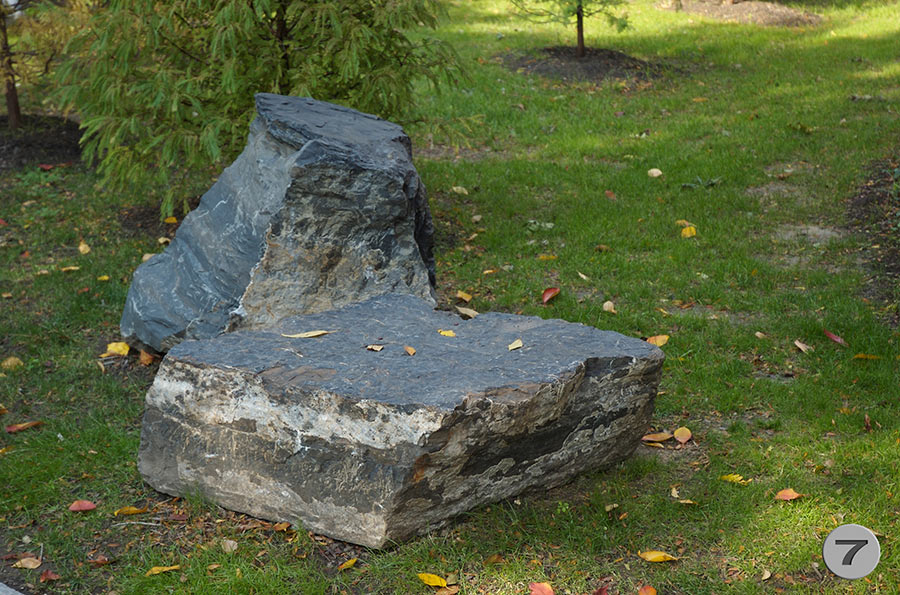 avy top a bedding surface that fell dry. Consequently we do not just have a wavy surface but also deep ridges that were originally mud cracks that were filled with different and now more resistant material. The white material that runs through the rocks in straight lines in a pattern and also covers the sides of both rocks are mineral depositions that happened in cracks (joints in geological terminology) that formed in the rocks while they were deep in the Earth. The rocks do now preferentially break where the mineral matter had been deposited.
avy top a bedding surface that fell dry. Consequently we do not just have a wavy surface but also deep ridges that were originally mud cracks that were filled with different and now more resistant material. The white material that runs through the rocks in straight lines in a pattern and also covers the sides of both rocks are mineral depositions that happened in cracks (joints in geological terminology) that formed in the rocks while they were deep in the Earth. The rocks do now preferentially break where the mineral matter had been deposited.
The next block, which is brownish grey and shows a little bit of reddish tint, is a sandstone (8), about 390 million years old of the Devonian age. This block shows several colors because it is well weathered and shows the color of the fresh rock only in a few places. There is a layer with fossils of shelled animals. The shells have weathered out and we see only the round shape of the exterior or interior of the shells.
Going a little bit further we see on the left some small trees and shrubs that represent a Tertiary swamp forest (9), consisting of living fossils, in other words species that are related to those forms that existed 10-35 million years ago and formed extensive lignite deposits. While the lignite or brown-coal deposits of the eastern United States are relatively limited and have largely been mined out, lignite is mined today extensively in Wyoming and even shipped east to power plants.
Going further to the next corner we see on the east side a gray limestone and dolomite (10) block with whitish and yellowish to brown layers. This rock was deposited in the area of southeastern Pennsylvania in a shallow ocean, about 500 million years ago during the Cambrian Period. It is now quarried extensively for use in road building and concrete.
Going towards the two benches (11a) we see a commemorative plate of rock embedded in the walkway with the inscription Class of 1957 Geology Garden (11b, at the bottom of page) and a commemorative tablet on the wall of Hayden Hall.
Across from the benches can be found a small Gingko forest (12a) with a ground cover of ferns (12b). This forest is similar to those that existed on Earth 100-220 million years ago from the Triassic to the middle of the Cretaceous Periods, when there were no flowering plants yet.
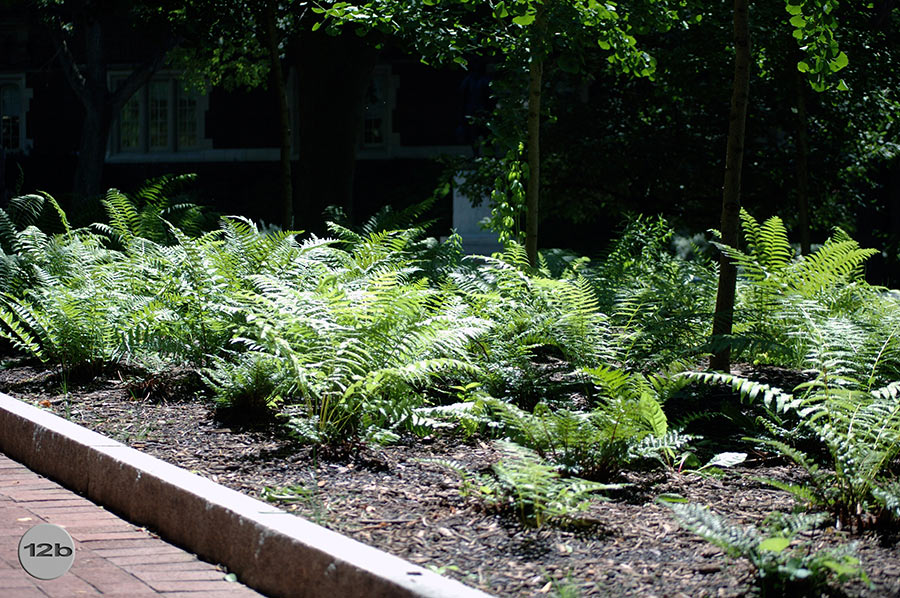
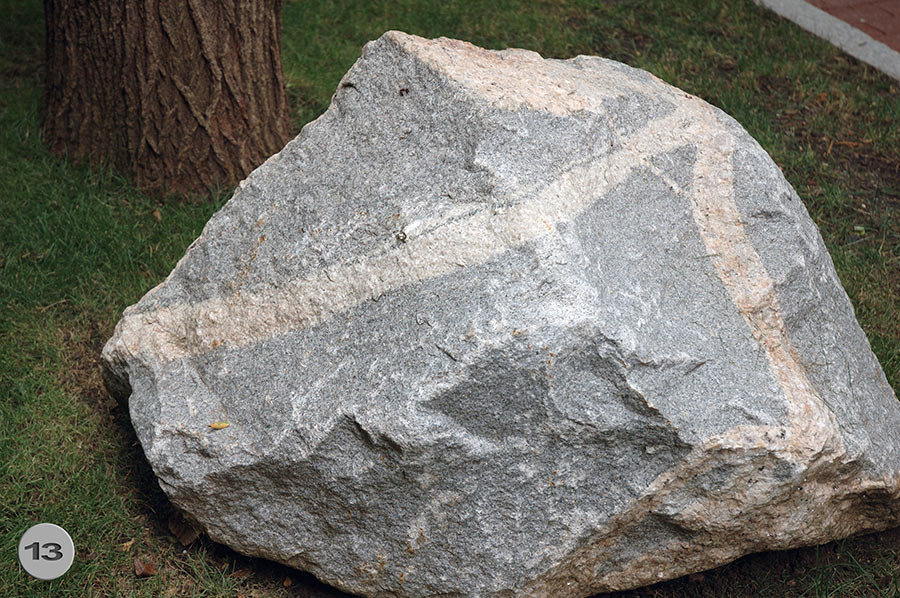 In the same area, but along the walkway towards 33rd St. are three more blocks of rock. On the corner we see a grey granular rock with white-to-pinkish bands running through it. This is a granodiorite (13) of Precambrian age, about one billion years old. This rock formed when magma or molten rock intruded into even older rocks. After the magma cooled and consolidated it was fractured by forces in the Earth. Along the fractures a slightly different magma entered and solidified as the white and pinkish bands with some black minerals in a few places.
In the same area, but along the walkway towards 33rd St. are three more blocks of rock. On the corner we see a grey granular rock with white-to-pinkish bands running through it. This is a granodiorite (13) of Precambrian age, about one billion years old. This rock formed when magma or molten rock intruded into even older rocks. After the magma cooled and consolidated it was fractured by forces in the Earth. Along the fractures a slightly different magma entered and solidified as the white and pinkish bands with some black minerals in a few places.
View of the three Precambrian rocks (15, 14, 13 from top to bottom of picture) as seen from a window in Hayden Hall looking towards 33rd Street. The serpentinite is the boulder in the middle partially behind the tree in this view.
The boulder closest to 33rd Street is a rare greenish gneiss (15) that is also approximately 1 billion years old. This gneiss was originally a different rock that was later moved deep into the Earth by natural forces and altered without every becoming liquid. Long after this alteration it was lifted back up to the Earth surface. This gneiss is quarried in southeastern PA for the material we need for road building and concrete.
In this short walk we have traversed 1 billion years of time with boulders of rocks that come from the area surrounding Philadelphia and four different plant communities that represent different times and different environments.
When the Geology Garden was created we could not include all the rocks that should be there, for instance from the slate belt or the Anthracite Fields. In addition, the garden needs labels cut into stone slabs embedded in the sidewalk and several slate blocks that can form the seats of an open-air “classroom.” Also, added plants for the four floras could contribute to a more nature-like appearance of the already beautiful area. We hope to add those features as funds become available.

We thank the Alumni who picked up on the idea of a geology garden and supplied the resources to make this garden possible. We invite you to come, visit the garden and read the plaque on the southeast side of Hayden Hall that acknowledges the alumni who at their fiftieth reunion made this garden possible. We also thank the quarry operators who donated boulders for this project.


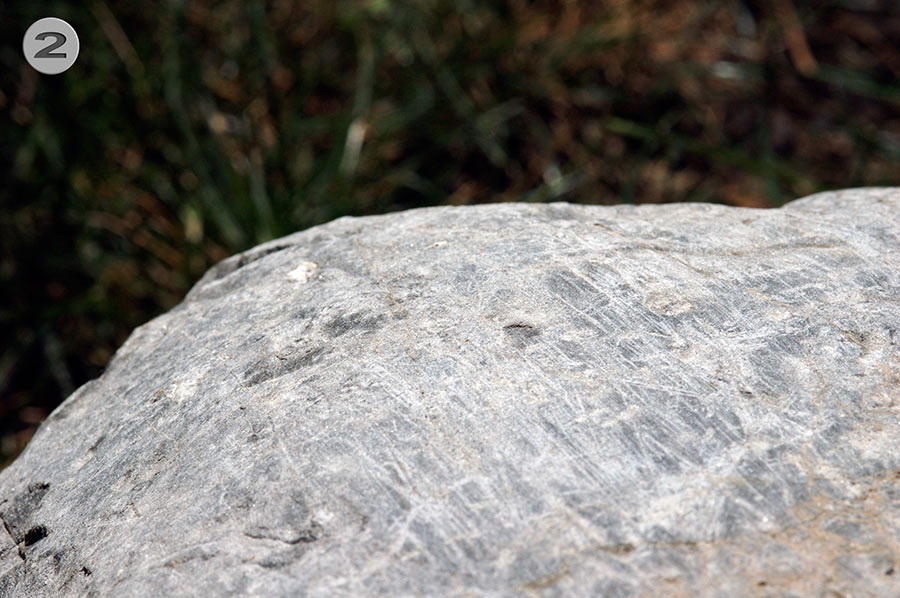
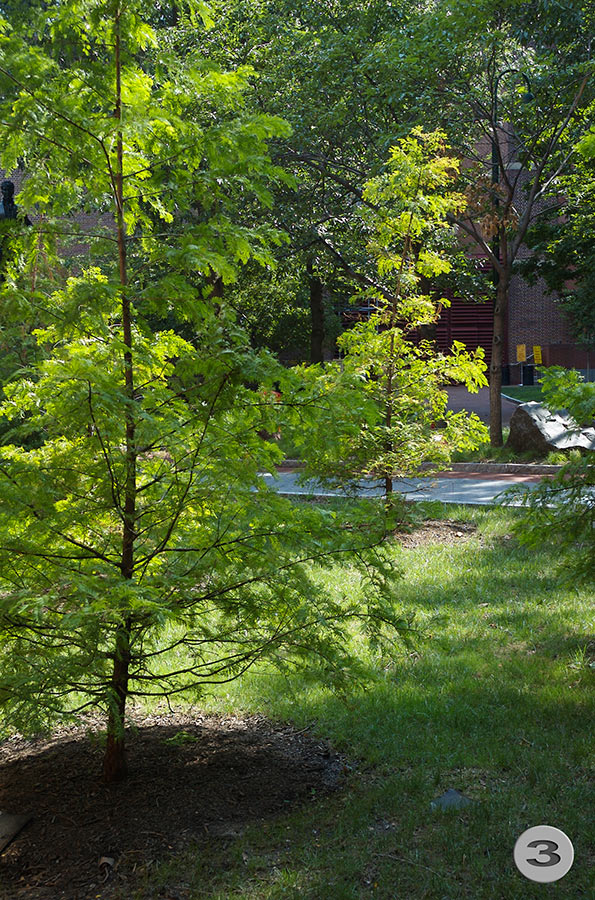
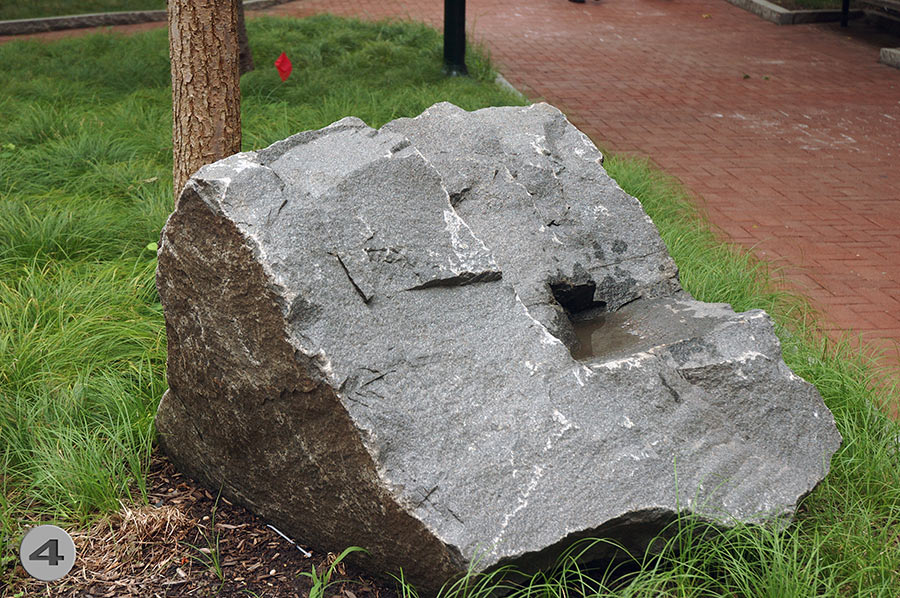
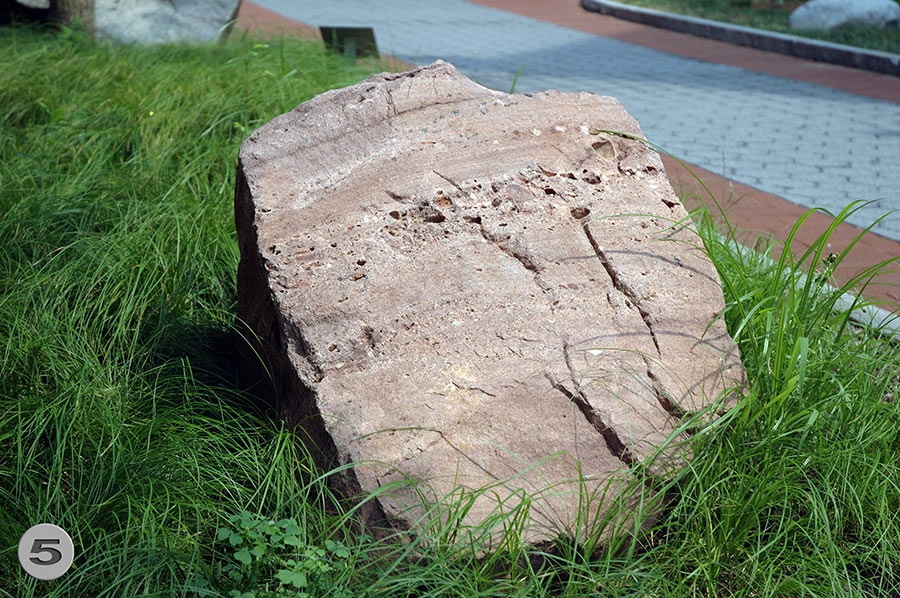
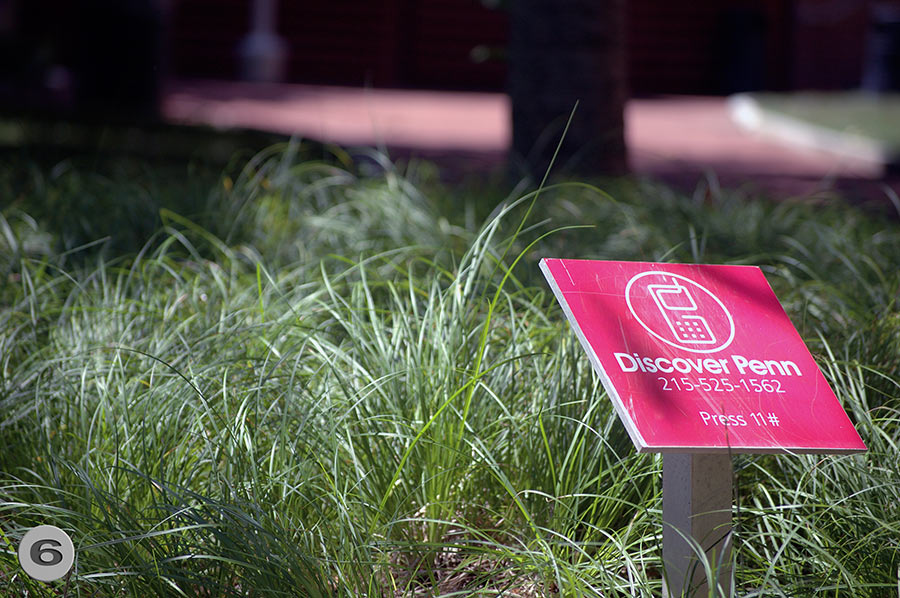
 avy top a bedding surface that fell dry. Consequently we do not just have a wavy surface but also deep ridges that were originally mud cracks that were filled with different and now more resistant material. The white material that runs through the rocks in straight lines in a pattern and also covers the sides of both rocks are mineral depositions that happened in cracks (joints in geological terminology) that formed in the rocks while they were deep in the Earth. The rocks do now preferentially break where the mineral matter had been deposited.
avy top a bedding surface that fell dry. Consequently we do not just have a wavy surface but also deep ridges that were originally mud cracks that were filled with different and now more resistant material. The white material that runs through the rocks in straight lines in a pattern and also covers the sides of both rocks are mineral depositions that happened in cracks (joints in geological terminology) that formed in the rocks while they were deep in the Earth. The rocks do now preferentially break where the mineral matter had been deposited.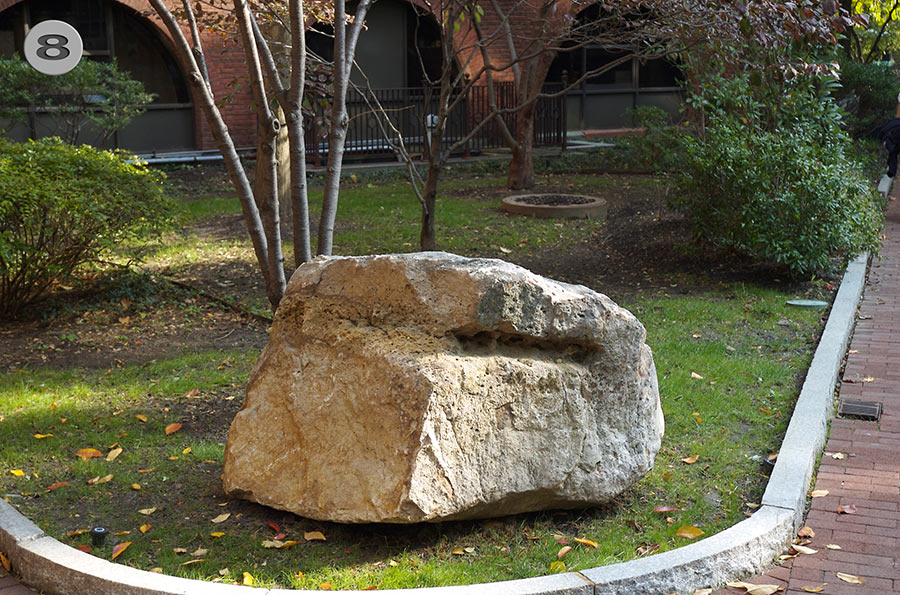
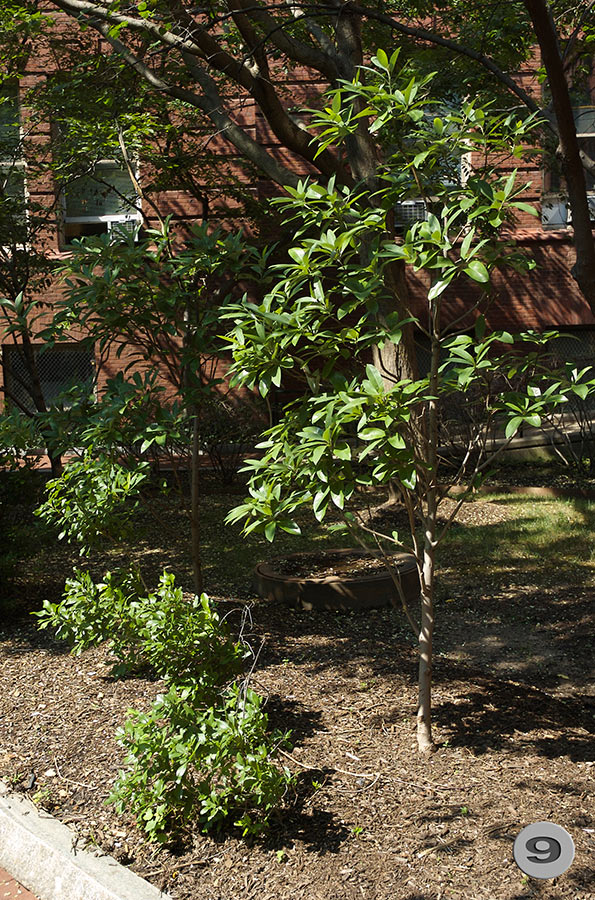
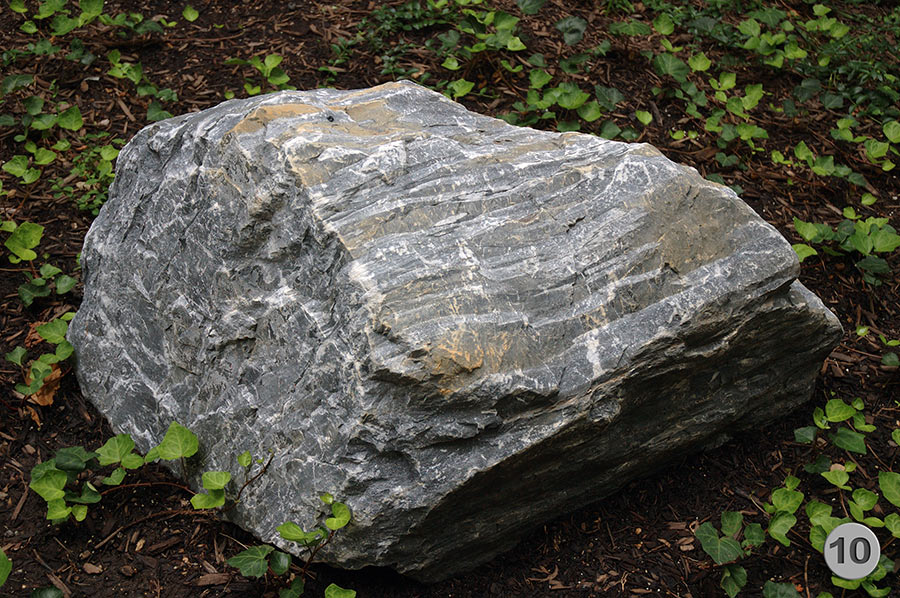
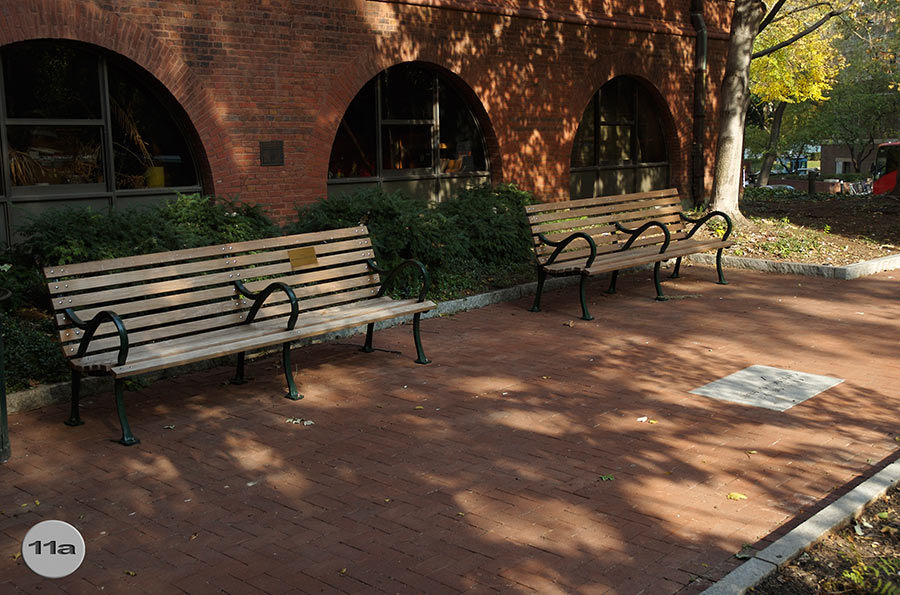
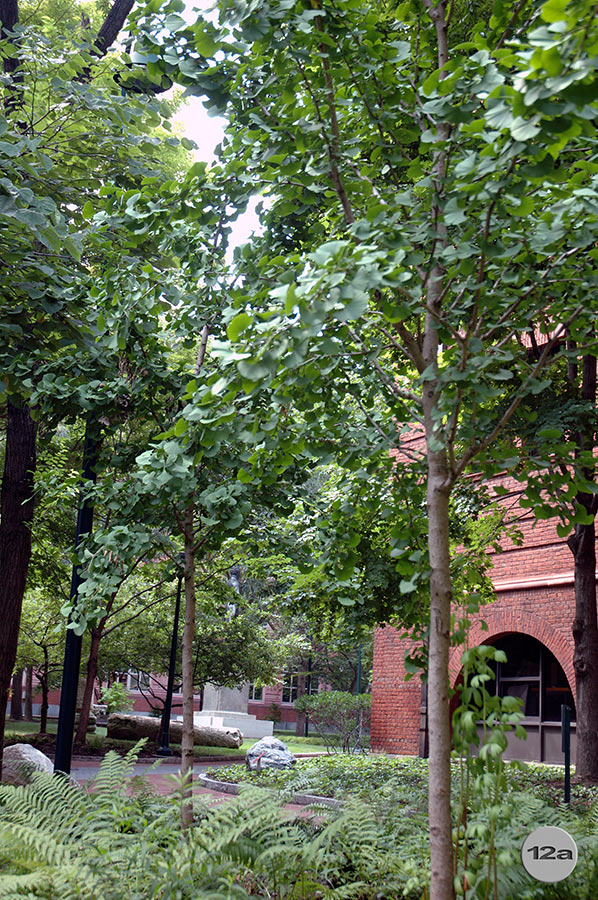
 In the same area, but along the walkway towards 33rd St. are three more blocks of rock. On the corner we see a grey granular rock with white-to-pinkish bands running through it. This is a granodiorite (13) of Precambrian age, about one billion years old. This rock formed when magma or molten rock intruded into even older rocks. After the magma cooled and consolidated it was fractured by forces in the Earth. Along the fractures a slightly different magma entered and solidified as the white and pinkish bands with some black minerals in a few places.
In the same area, but along the walkway towards 33rd St. are three more blocks of rock. On the corner we see a grey granular rock with white-to-pinkish bands running through it. This is a granodiorite (13) of Precambrian age, about one billion years old. This rock formed when magma or molten rock intruded into even older rocks. After the magma cooled and consolidated it was fractured by forces in the Earth. Along the fractures a slightly different magma entered and solidified as the white and pinkish bands with some black minerals in a few places.